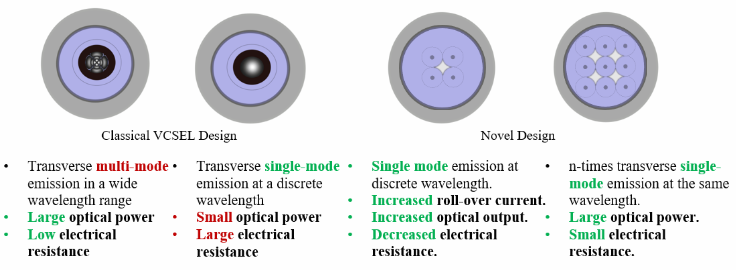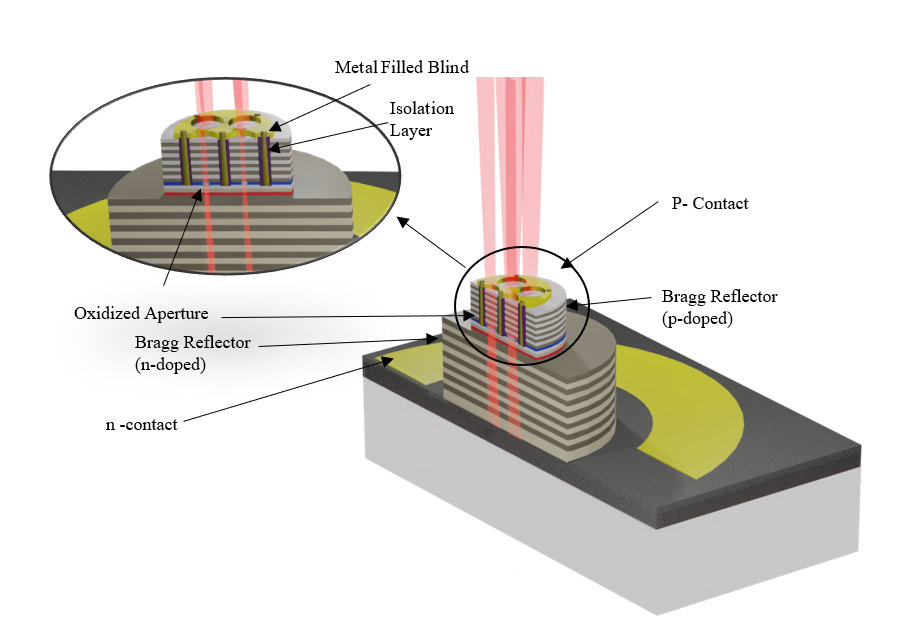Author: Mansoor Ahamed |
Vertical cavity surface emitting lasers (VCSELs) present the basis for large data rate optical interconnects in data centers. Presently VCSELs have replaced edge-emitting lasers for distances below 500 m due to their advantages such as on-wafer test possibility. The demand for VCSELs and in particular, arrays has most recently significantly increased due to the trend for wavelength multiplexing in data centers and the development of automobile applications like short-range LIDAR.
A recent study published in IEEE Xplore and by the Bimberg Chinese-German Center for Green Photonics, Changchun Institute of Optics, Fine Mechanics and Physics (CIOMP) of the Chinese Academy of Sciences reported progress on novel multi-aperture VCSELs (patented). The development of multi-aperture VCSELs leads to performance advantages such as larger temperature roll-over, larger output power, and larger f3dB (the decisive parameter determining the bit rate of communication). This design was recently presented for the first time at ISLC 2021 in Potsdam, Germany.

Figure 1. Comparing Novel VCSEL Design and Classical VCSEL Design (Image by Mansoor).
The novel design is based on fabricating variable shape oxidized apertures from multiple etched blind holes of any geometric arrangements. After oxidation, the blind holes are filled with metal. The metal-filled blind holes efficiently remove heat from the device and allow low resistance current injection to the active area. Hence the device can operate across a wide range of temperatures and higher frequencies. One mesa may contain one or more emitters still matched to a 50 μm diameter fiber. Moreover, the novel MAVs fabrication process is compatible with the present semiconductor manufacturing infrastructure foundry.
Novel multi-aperture VCSEL demands a complete redesign to realize the final device. Classical VCSELs with a narrow oxide aperture show single-mode emission at discrete wavelength, resulting in small output power. Novel multi-aperture VCSEL design with ‘n’ number of apertures can produce 'n’ number single-mode emission at the same discrete wavelength with n times the output power, lower operating temperature of the active area, larger f3dB, compared with the classical VCSEL design.

Figure 2. Novel VCSEL Design (Image by Mansoor).
Another significant advantage of the novel design is single-mode emission with much increased output power, thereby extending the single-mode communication distance up to a kilometer. Tuning the aperture shape away from a circular shape will result in polarized emission.
Most importantly, single-mode or multi-mode multi-aperture VCSELs will exhibit smaller series resistance (compared with present classical VCSEL). Therefore, it will be easy to drive by novel high-speed CMOS driver circuits. The module’s energy consumption is much lower, which is an essential step towards green photonics.
Mansoor Ahamed
Bimberg Chinese-German Center for Green Photonics
E-mail: mansoor@ciomp.ac.cn
